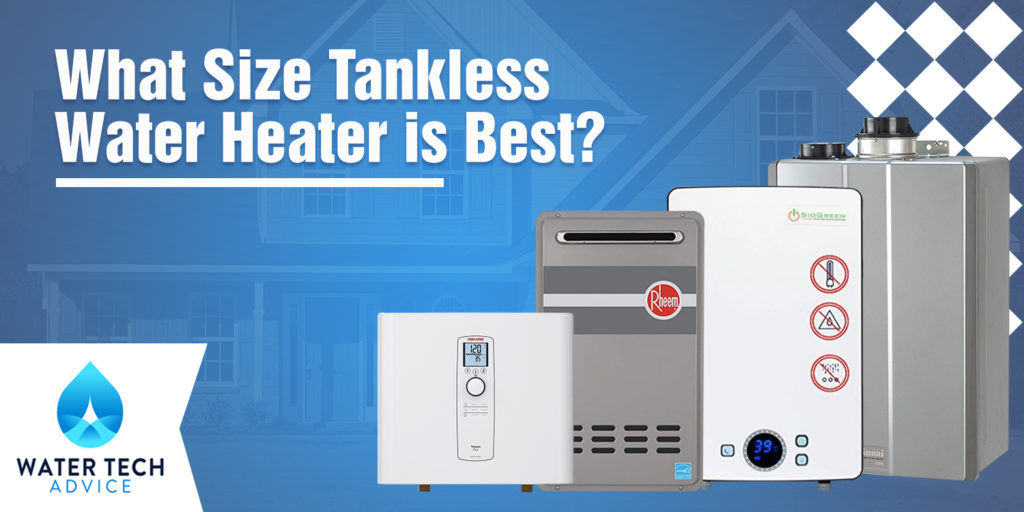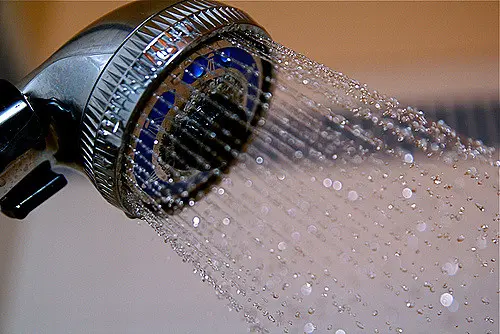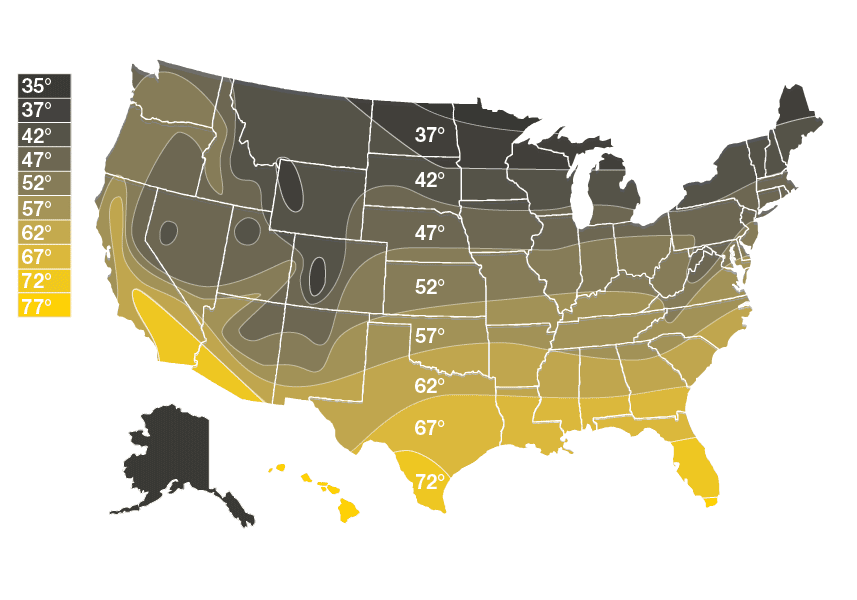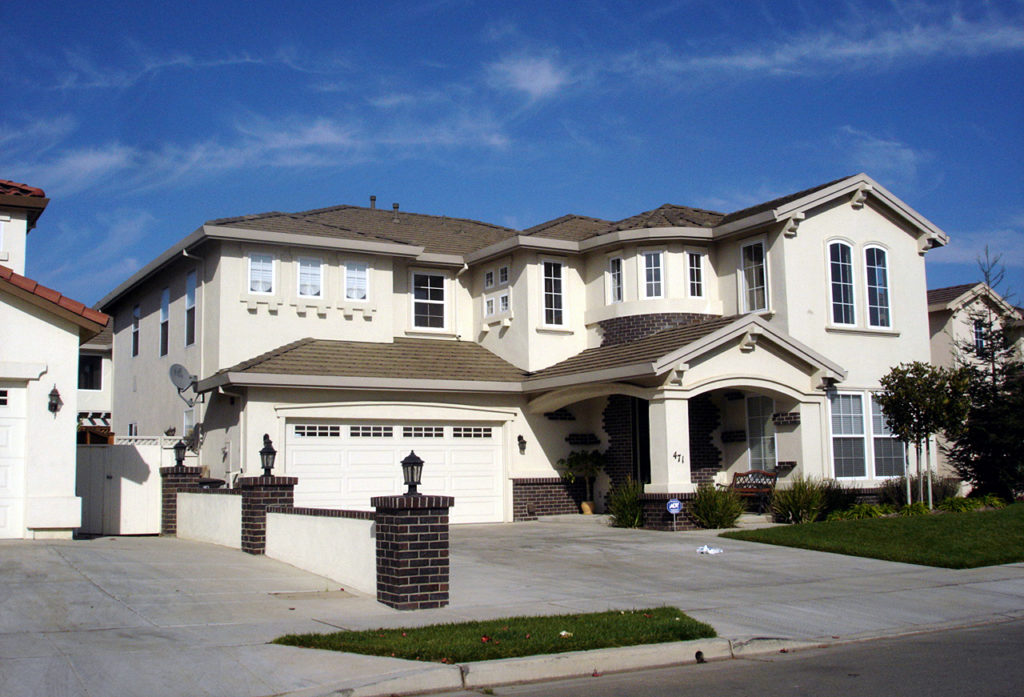
If you’re interested in installing a tankless water heater but are overwhelmed by the options, you are not alone!
Many homeowners are stuck asking the question, “What size tankless water heater do I need?”
Our guide will help you figure out what size tankless water heater is best for you.
In this article, we will walk you through the exact calculations in a step-by-step manner so that you can pick a tankless water heater that supplies the required amount of hot water to your home and ensures that you will never run out of hot water.
Table of Contents
- 1 How to Size a Tankless Water Heater
- 2 Step 1: Calculate How Many GPM for Your Tankless Water Heater
- 3 Step 2: Determine Temperature Rise Needed
- 4 Step 3: Determine Your Power Source
- 5 What Size Tankless Water Heater Does a Family of Four Need?
- 6 What Size Tankless Water Heater For a Couple In a Condo?
- 7 What Size Tankless Water Heater Does a Family of Five Need?
- 8 So, How Big of a Tankless Hot Water Heater Do I Need?
How to Size a Tankless Water Heater
The first factor in choosing a tankless water heater is calculating the size of your hot water heater.
While traditional tank water heaters are calculated by your family size, a tankless water heater is calculated by the quantity and types of fixtures or appliances it will serve.
The resulting figure is called “GPM” (Gallons Per Minute), or sometimes “flow rate”, which helps determine your hot water heater size.
Let’s walk through how to calculate and pick the correct size tankless water heater.
Step 1: Calculate How Many GPM for Your Tankless Water Heater

You can calculate your own maximum GPM by adding up the flow rate of each individual fixture that uses hot water in your home.
This is just a way of measuring how many gallons of hot water could run through the fixture per minute. You can find actual flow rates for your specific fixtures by referencing your owner’s manual or searching the model number online.
GPM Needed = Sum of All Individual Hot Water Appliance GPM Rates Which Run at Same Time
If you don’t have original paperwork or a model number, you can use a generic GPM number for your type of fixture.
Locate this information with GPM estimate charts, which are readily available with a quick google search. You can even search “How big of a tankless hot water heater do I need?” and the results (like this one) will surely include one of these easy-to-use charts.
The example chart below helps you easily figure what size tankless water heater you need. Write down each GPM figure, whether it is your fixture’s true GPM or an estimate, then add them up. Include any fixtures that would run at the same time, and only if they will use hot water.
(Source)
Remember, if you don’t want to run out of hot water, you should overestimate how many of these fixtures could be on at the same time!
Step 2: Determine Temperature Rise Needed
In addition to the amount of water you need to move, you next must consider how much the water needs to be warmed.
Temperature rise, or the amount you need to increase the temperature of groundwater to reach your desired “hot” temperature, is another calculation.
This temperature is just a preference but is typically around 120 degrees Fahrenheit.
You can easily find your region’s average groundwater temperature using a ground temperature map. There are a variety of versions, some listing temperature ranges over larger areas, while others provide more specific temperatures for smaller areas. The map you choose to use in sizing a tankless hot water heater is just a matter of preference.
Whichever method you choose, subtract the groundwater temperature from your desired hot water temperature to calculate temperature rise. This is another specification you will use to pick how big of a water heater you need.
Temperature Rise Needed = Desired Water Temp – Incoming Groundwater Temp

Step 3: Determine Your Power Source

The power source for your tankless water heater is the next consideration. There’s no easy answer as to whether gas or electric tankless water heaters are better, as it depends on your own circumstances and preferences.
Electric tankless water heaters are typically better suited for point of use applications and in homes with smaller water demands. Electric is usually only preferred in places with warmer incoming water temperatures and smaller heating and GPM requirements.
Gas, on the other hand, is usually the best choice for homes with large water demands like whole house use, as well as lower groundwater temperatures.
First, you should consider the availability of the power source you’d like to use; Does your home already have gas or electrical access? This, alone, may be enough to make up your mind. If not, there are a few other factors that may help you choose a power source for your tankless water heater. In most regions, gas may be much more affordable for long term use.
If the price and availability of gas and electric are fairly similar in your region, you may also want to consider which features of a tankless water heater are most important to you. Gas-fired tankless water heaters are able to produce a larger volume of hot water more quickly than their electric counterparts. They are also typically less expensive to operate due to the price of gas, but this could vary depending on your area.
Electric tankless water heaters, on the other hand, are much more affordable and simple to install, as they don’t require fuel piping or venting. The simpler installation will also decrease labor costs, further cutting initial costs for the buyer. Think twice about an electric tankless water heater, though, if your town has inconsistent electrical service. Unless attached to a battery backup, a power outage will cause you to lose hot water.
Now that we have an understanding of important terminology and factors for choosing a tankless water heater, let’s explore some examples.
What Size Tankless Water Heater Does a Family of Four Need?

A family of four in an average sized home would need to consider how many people in the home might be running hot water at the same time. First, to calculate their maximum GPM, we will add up the flow rates for each fixture.
Our example family could potentially need to run the following appliances at the same time:
- Dishwasher (2 GPM)
- Kitchen sink (3 GPM)
- Up to two showers (1.5 GPM each) at the same time
Based on the low end for ranges of each fixture on our GPM chart above, assuming the family bought efficient appliances, this would be 6.5 GPM.
We would then calculate the tankless water heater temperature rise based on the region they’re in.
For example’s sake, we will say Hawaii. If they stick to the average 120 degrees Fahrenheit hot temperature, they will require a 43-degree rise from the average 77-degree groundwater temperature for the region.
120 degrees (temperature wanted) – 77 degrees (incoming groundwater temperature) = 43 degree rise needed
This couple will need a 43-degree temperature RISE @ 6.5 GPM.
In this scenario, if the family was limited to electric models, a higher volume tankless water heater, like the EcoSmart Eco 27 Electric Tankless water heater would be a good choice.
What Size Tankless Water Heater For a Couple In a Condo?

A couple in a Florida condo, on the other hand, will have a totally different set of needs.
Their condo has one bathroom, and no on-site laundry or dishwasher. They know that their brand new kitchen faucet is rated at 1.5 GPM, but use the generic numbers from the GPM calculation chart to reach a flow rate of just 5 GPM.
They’ll only have to raise their temperature from the average 68 degrees to their desired 110-degree hot water. This couple should use these specifications to select a tankless water heater capable of 42-degree rise at 5 GPM.
The affordable Rheem RTEX-36 Electric Tankless Water Heater would be a great choice for this couple, which could easily cover the water demand, plus provide energy and space savings.
What Size Tankless Water Heater Does a Family of Five Need?

Our last example is a family of five in a large home that does have access to gas lines.
This home has all the same appliances as our first family, plus an extra half bathroom, adding another bathroom faucet at 1.5 GPM. Of those, we suspect that they could be running two of the showers, plus the dishwasher, washing machine and half bathroom faucet at the same time, so we add their GPMs to reach 9.5 GPM.
The groundwater temperature at their home in Oklahoma is 57 degrees, and the family prefers their hot water to be 120 degrees. They know that they need one capable of a 63-degree temperature rise at 9.5 GPM.
Now that this family can answer the question, “What size electric tankless water heater do I need?”, they just need to pick a good tankless water heater.
One option would be the Rheem RTGH-95DVLN 9.5 GPM Indoor Direct Vent Tankless Natural Gas Water Heater. As long as the family did not exceed the projected water use, it would provide enough water while achieving a 94 percent efficiency rating.
So, How Big of a Tankless Hot Water Heater Do I Need?
If you would like to calculate your own tankless water heater size, just follow the same steps as above.
- Calculate the GPM by adding up fixtures used in your home
- Find your temperature rise based on desired temperature and groundwater temperature
Once you have the size of tankless water heater selected, your only remaining decision is the power source type.
Decide between a gas tankless water heater or electric heater, then you can start shopping! Specifications matching your calculations can be found directly on the heater’s spec plate or packaging as well as most vendors’ and manufacturers’ websites.
Think of it as shopping for a car by horsepower and mileage per gallon.
Now that you know what you’re looking for, it’s time to grab your heater. Check out our review of the best tankless water heaters today!


